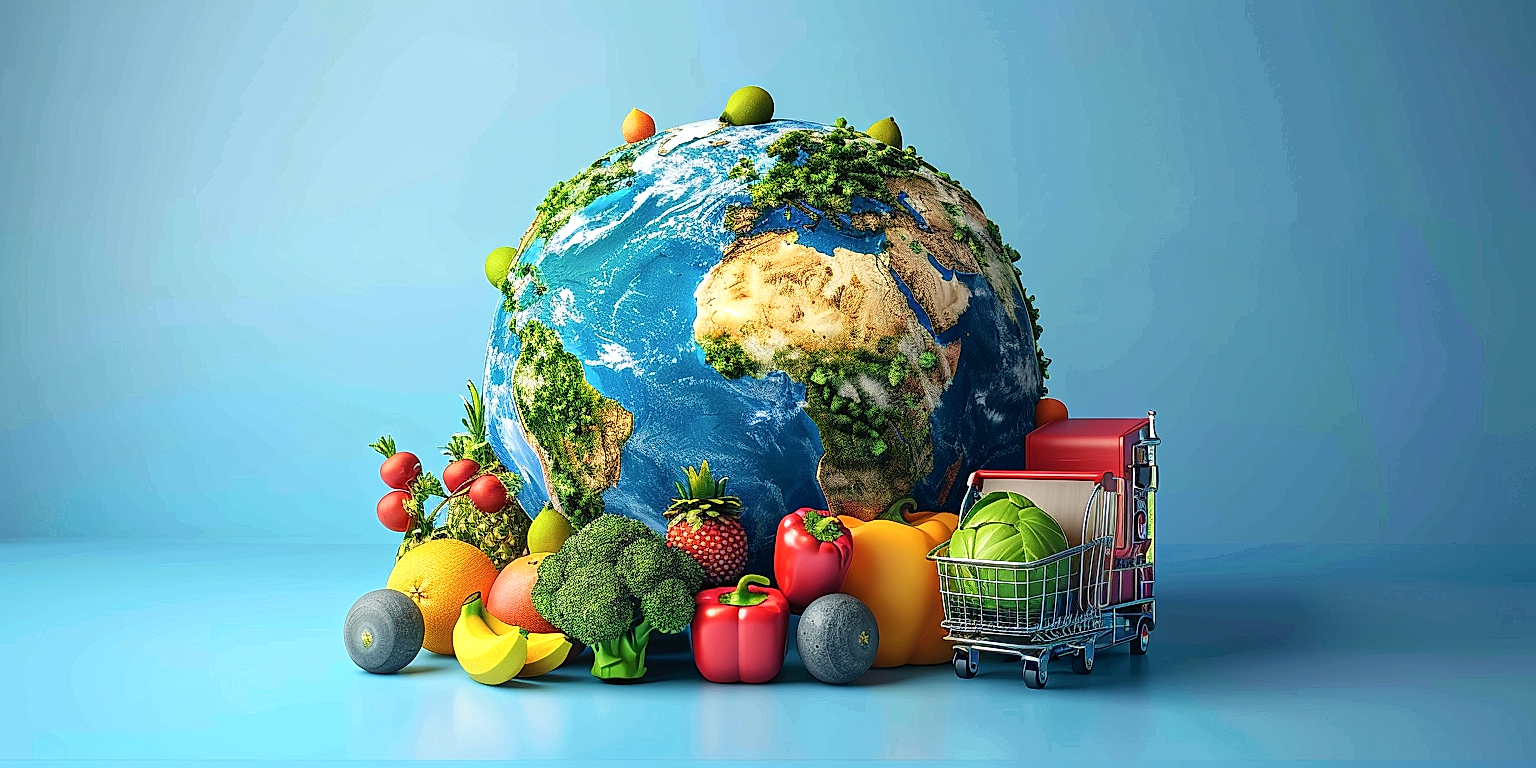Navigating the ins and outs of produce shipping presents various complexities.
Sustainability, in particular, is a vital factor that often poses significant challenges.
However, proper management of these hurdles can lead to considerable long-term benefits.
This article focuses on the critical aspects to consider while building a sustainable business methodology in produce shipping.
Our discussion delves into issues such as carbon footprint, packaging options, and policy compliance among other factors.
Understanding these components is fundamental for any entity seeking to make a positive impact in this business landscape.
Key Considerations For Sustainable Trade In Produce Shipping
1. Minimize Carbon Footprint in Transport Methods
In the context of sustainable trade in produce shipping, one of the key aspects to consider is the minimization of carbon footprint in transport methods.
Strides are being taken worldwide to reduce the overall carbon emissions in the trade and shipping industry.
By reducing carbon emissions, the transportation of goods can thus become more environment-friendly and sustainable.
For instance, intermodal transport systems with biodiesel-driven trucks are slowly emerging as a favorable alternative.
Choosing modes of transportation that have less environmental impact is becoming increasingly significant.
Furthermore, logistical companies are investing heavily in reducing the carbon footprint, enhancing efficiency, and raising sustainability levels.
Routinely reviewing and updating the efficiency of trade and shipping methods is another key point of focus.
Changing technology and economic situations make it imperative to continuously seek new ways to decrease carbon emissions in transport methods.
Endeavors to minimize fuel consumption such as proper vehicle maintenance, driver education, and strategic transportation planning further contribute to declining the overall carbon footprint.
The implementation of green strategies in supply chain management would result in decreased carbon emissions and overall improved efficiency of transport methods.
Future technological advances, such as electric vehicles and solar-powered vessels, are anticipated to play a huge role in achieving sustainability in transport methods.
It is important to note that minimizing carbon footprint in transport methods requires corporate commitment and a clear plan of action.
However, this doesn’t necessarily mean compromising on service quality or incurring unbudgeted expenses as solutions like route optimization and inventory management can lower the carbon footprint as well as cost-effectively increase efficiency.
The incorporation of renewable energy sources in transport methods is another futuristic approach towards achieving sustainability in produce shipping.
Such measures not only aid in reducing carbon emissions but also propel the industry towards a viable, environment-friendly future.
In summary, several strategies and alternatives are available for businesses to minimize carbon footprint in transport methods.
Therefore, they should be encouraged to figure out which measures would work best for them, considering their specific structure and operations, and to employ them for a more sustainable produce shipping.
2. Use Renewable Energy for Shipping Facilities
With growing emphasis on sustainability, the need to incorporate renewable energy in shipping facilities is increasingly critical.
The systemic adoption of renewable energy in shipping facilities is not just an abstract idea, but a dire requisite for preserving the environment.
The shipping industry, being a notable contributor to global emissions, needs to expeditiously transition to more sustainable methods.
Renewable energy for shipping facilities is crucial in curbing the industry’s carbon footprint and making its operations truly sustainable.
Renewable energy, especially wind, solar, and hydroelectric power, offers a feasible solution in significantly lowering the industry’s carbon footprint.
These forms of renewable energy are not only abundant and environmentally friendly but also increasingly cost-effective.
Adopting renewable energy in shipping facilities, therefore, translates to decreased operating costs in the long run.
Moreover, renewable energy-driven shipping facilities could help the industry achieve its sustainability targets in the long run.
There is a substantive need to align business operations with sustainability objectives, and renewable energy adoption is a step forward.
However, the transition to renewable energy shouldn’t be viewed as a potential disruption, rather an opportunity for liberalising innovation.
Besides, it’s worth noting that the push towards renewable energy needs to be a concerted effort from manufacturers, consumers, and regulatory bodies alike.
The goods transported are integral to our everyday lives, making it imperative for the shipping industry to witness substantive changes.
Indeed, adapting to renewable energy can catalyse this change, providing a sustainable alternative to the currently prevalent fossil fuel consumption.
To put it simply, incorporating renewable energy into shipping facilities ensures not just economic efficiency, but also contributes significantly towards environmental preservation.
Thus, using renewable energy in shipping facilities should be on the top of the industry’s agenda, taking a step towards a greener future.
3. Prioritize Eco-Friendly Packaging Materials
In the realm of sustainable trade, one key area to consider is the use of eco-friendly packaging materials in produce shipping.
Sustainable packaging not only minimizes ecological damage but also adds a reputational advantage for businesses in the eye of increasingly environmentally-conscious consumers.
Plastic, being non-biodegradable and dangerous to marine life, is a significant problem in terms of environmental pollution.
Trading firms can switch to more sustainable alternatives like packing items in biodegradable or plant-based plastics.
Similarly, using recycled paper and cardboard assists in reducing deforestation rates and the consequent negative impacts on climate change.
Switching to such eco-friendly packaging materials also saves resources by lowering the demand for new materials which require energy and water for production.
Businesses in the produce shipping sector must be proactive and inventive in their choice of eco-friendly packaging to support a sustainable trade environment.
Eco-friendly packaging also includes reducing the amount of material used in packaging, known as lightweighting.
This may involve redesigning packaging structures to use less material without compromising the quality or safety of the produce being shipped.
Implementing a returnable packaging system is another way to improve sustainability in produce shipping.
In this method, consumers return the used packaging to the retailer or manufacturer for reuse or recycling, therefore, closing the packaging lifecycle loop and reducing waste.
Furthermore, using natural adhesives or eco-friendly printing inks for packaging poses less threat to aquatic ecosystems.
This also safeguards human health as these inks and adhesives are free from harmful solvents and volatileorganic compounds.
In verifying that packaging materials are ecologically responsible, certifications like FSC (Forest Stewardship Council) for paper products or biodegradable certifications for plastics can be effectively used.
Such certifications ensure that the materials used have been produced in a sustainable and ethical manner.
Significant investments in research and development can also lead to innovative eco-friendly packaging solutions, enhancing sustainability and economic viability in the long run.
In all, the commitment to prioritizing eco-friendly packaging materials significantly contributes to sustainable trade in produce shipping.
4. Reduce Water Wastage in Produce Shipping
In the realm of trade, the role of water conservation is often overlooked, but it is of prime importance when it comes to sustainable produce shipping.
One of the main reasons for high water usage in the shipping industry is the cooling and refrigeration of perishable goods.
Reducing water wastage thus becomes a key consideration in the sustainability of global trade and commerce.
While it’s true that perishable goods require adequate refrigeration to maintain their freshness and longevity, methods can be devised to ensure this does not lead to excessive water wastage.
Innovative technologies and strategies can be implemented to create water-efficient cooling systems that not only lower water consumption, but also maintain the quality of the produce.
Drip irrigation systems, for instance, enable efficient water usage in the supply chain, thereby promoting sustainable produce shipping.
Produce shippers can also adopt water recycling systems in their operations. Such systems can recycle the water used for cooling, which can then be re-used for other purposes.
This optimized use of water not only contributes to a reduction in water wastage, but also results in cost efficiency for shippers.
Another effective way to reduce water wastage is to optimize the packaging of goods. Water-resistant packaging can help to minimize the need for additional protective materials, which often consume large quantities of water during their manufacturing process.
Furthermore, traders need to impose stricter regulations and controls to prevent water loss during transportation.
Regulations can also encourage other businesses to adopt more sustainable practices, setting a positive example in the industry on how to operate sustainably.
Education is also crucial in this context. By educating the workforce about the importance of water conservation and how to achieve it, businesses can make substantial strides towards reducing water wastage.
Another important note is that shippers should prioritize transportation routes that are less strenuous on water resources. For instance, choosing shipping routes that avoid areas suffering from water scarcity.
It is evident that businesses need to rethink how they operate to become more sustainable and water-efficient to ensure the sustainability of their operations, the health of our planet, and the future of global trade.
Reducing water wastage in produce shipping thus becomes not only an environmental need, but also a strategic business decision that can lead to cost savings, increased operational efficiency, and a stronger brand image.
5. Support Local Farming for Lower Emissions
Supporting local farming is an essential step for sustainable trade in produce shipping.
There are countless benefits to investing in local agriculture, not just for the economy, but also for the environment.
Local farming drastically reduces the amount of carbon emissions traditionally associated with long-distance transportation of produce.
By reducing the distance that produce needs to travel, we can significantly decrease the carbon footprint associated with delivering these goods.
Investing in local farming also encourages sustainable farming practices, which have less of an impact on the environment.
Local producers often use methods that are less reliant on chemical fertilizers and pesticides, contributing to better soil health and biodiversity.
In addition to being eco-friendly, these practices also help to reduce water wastage and maintain local soil fertility.
They also help to preserve local green spaces and wildlife habitats, contributing to the local ecosystem.
Furthermore, supporting local farming stimulates the local economy and creates jobs in the community.
A robust local economy reduces the need for imported goods, further reducing carbon emissions from transportation.
Supporting local farming, however, is not just about making purchases from local farmers.
It also involves policies and regulations that encourage local agricultural development.
This can be done by creating fair market conditions, providing financial support or incentives for local farmers, and implementing policies that promote responsible land use and environmental conservation.
Investing in local farming for lower emissions is a significant factor in creating a sustainable trade in produce shipping.
It’s a step that not only benefits the environment, but also strengthens communities and economies.
So, supporting local farming is not just a consideration for the sustainability of produce shipping; it’s an absolute necessity.
The Bottom Line
Undoubtedly, adopting green practices in shipping industries has become a necessity rather than an option, with an aim to safeguard our environment.
It is evident that through minimizing carbon footprints in transport methods, utilizing renewable energy in facilities, favoring eco-friendly packaging materials, reducing water wastage, and supporting local farming, we can substantially lower emissions.
Therefore, these strategies not only contribute to environmental conservation but also align with urban sustainability goals.
Businesses, industry stakeholders, and individuals must play a proactive role in fostering clean and green shipping, fostering a better, sustainable future for the generations to come.




